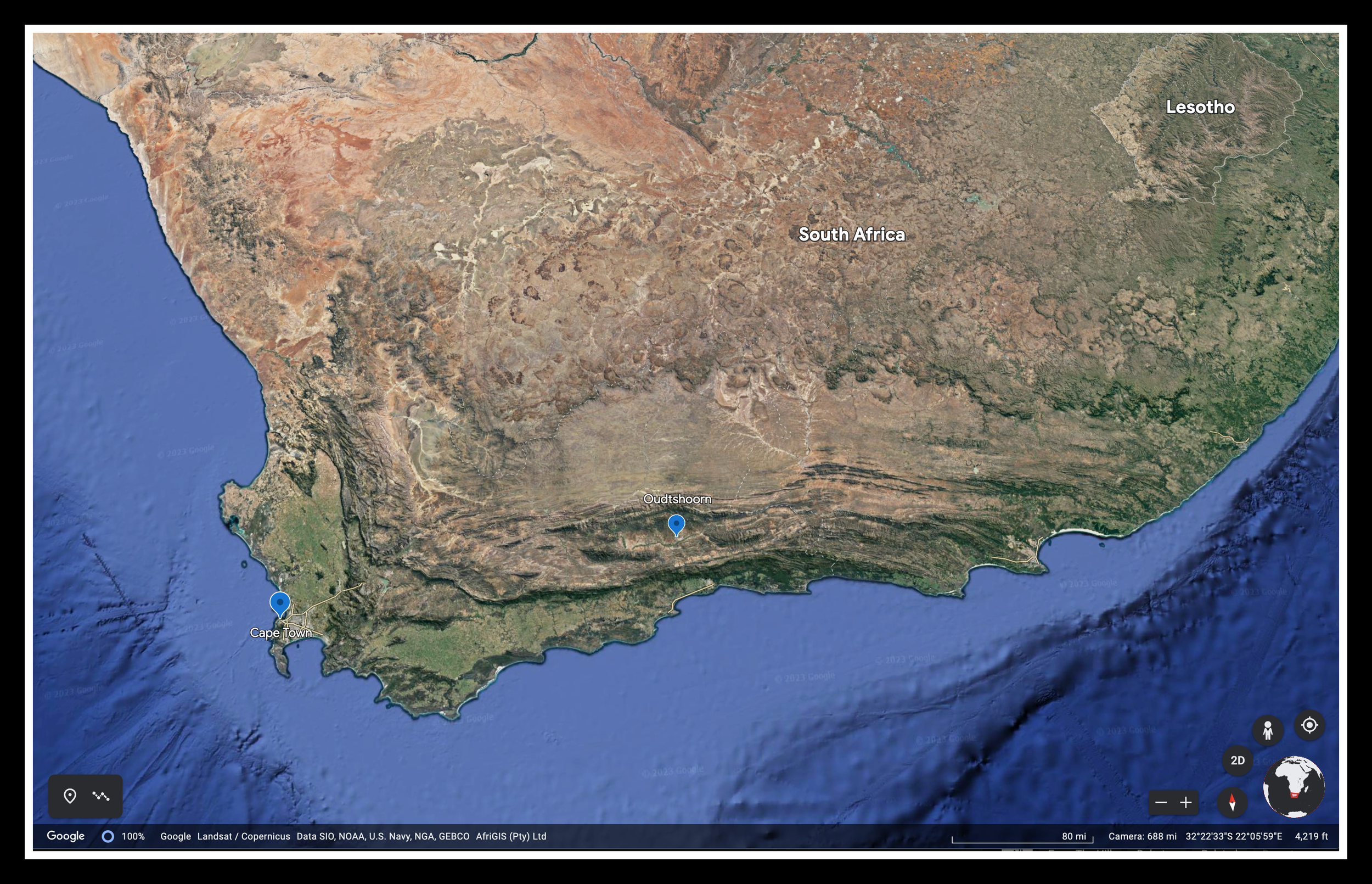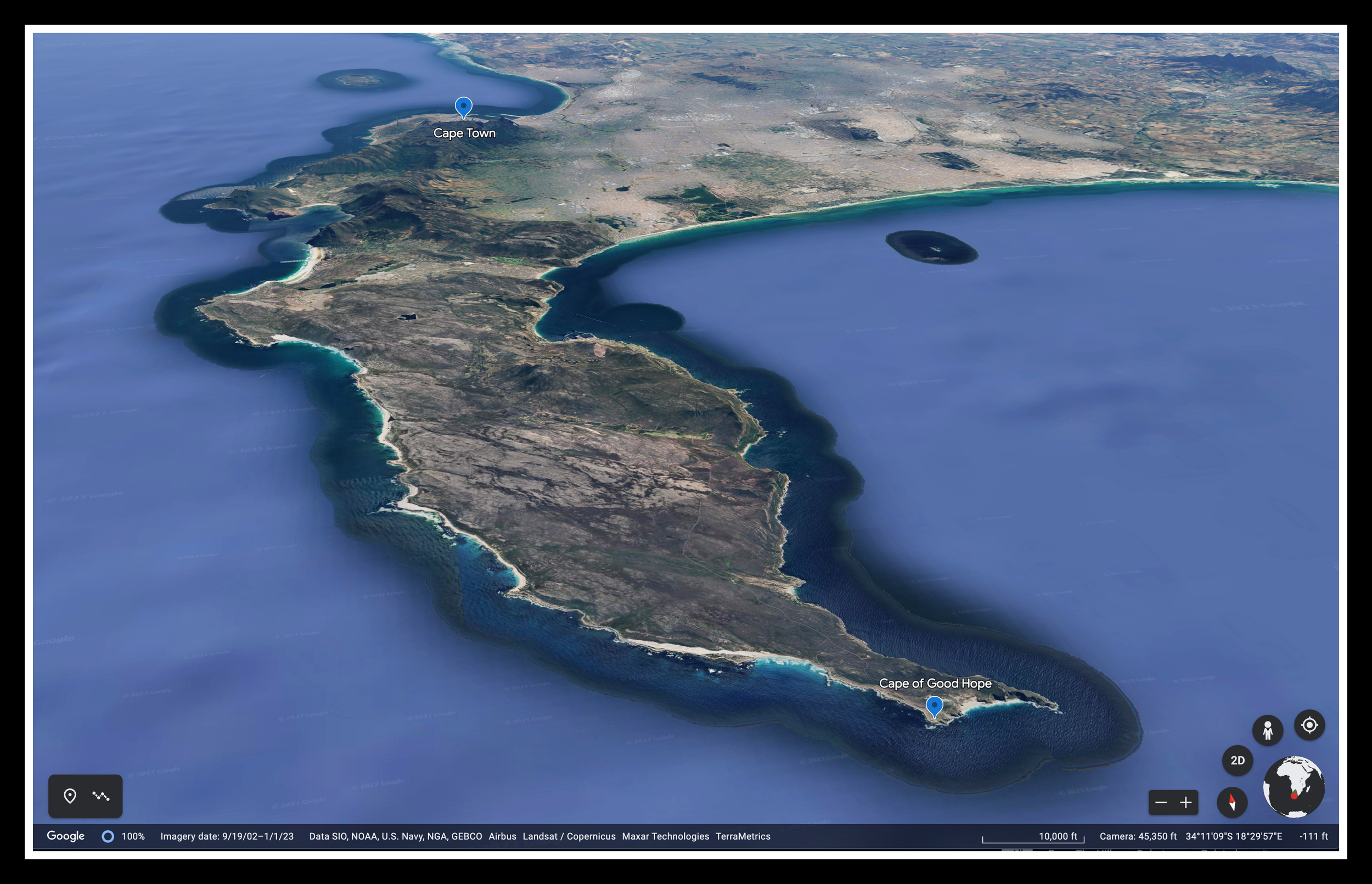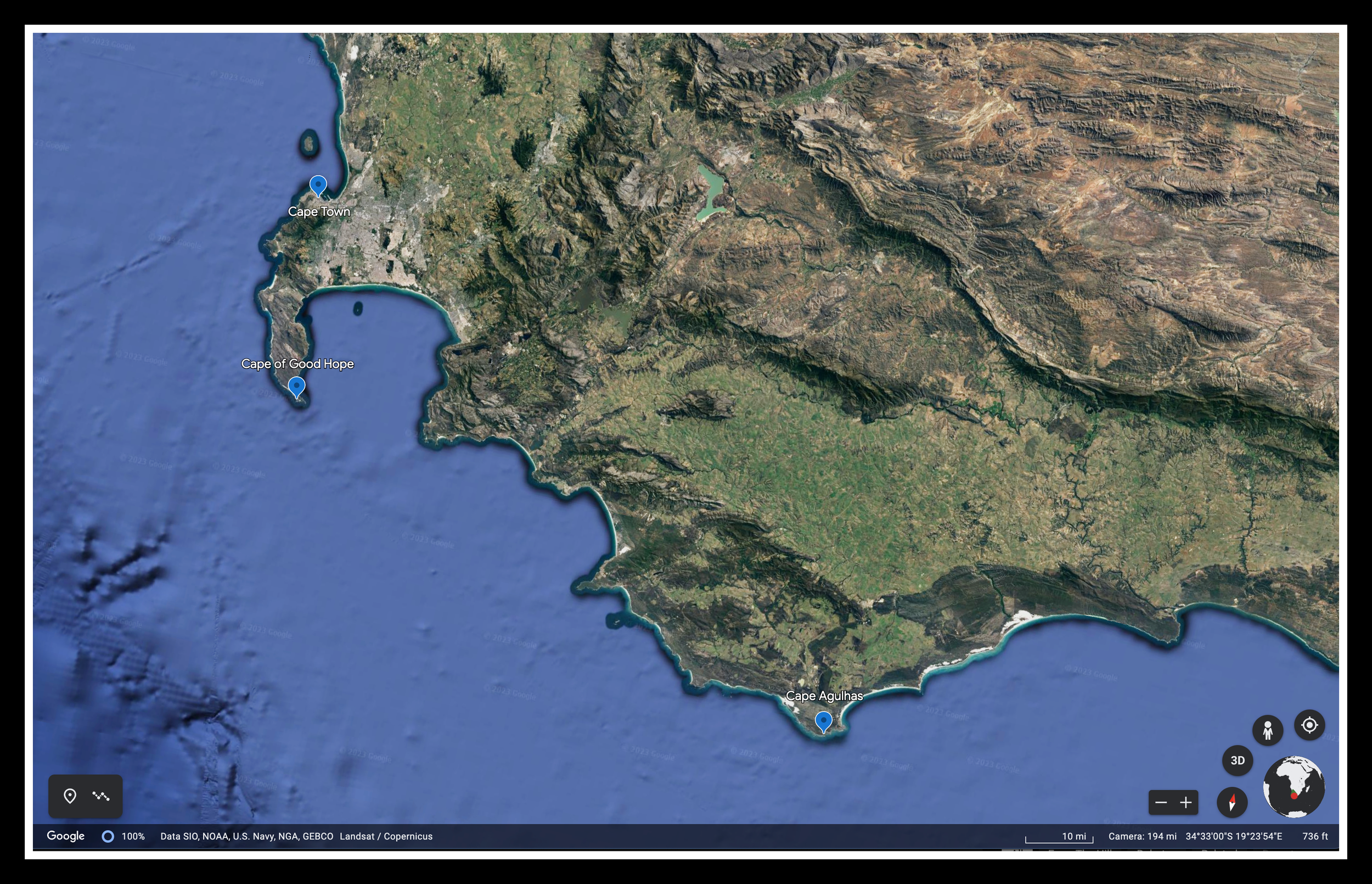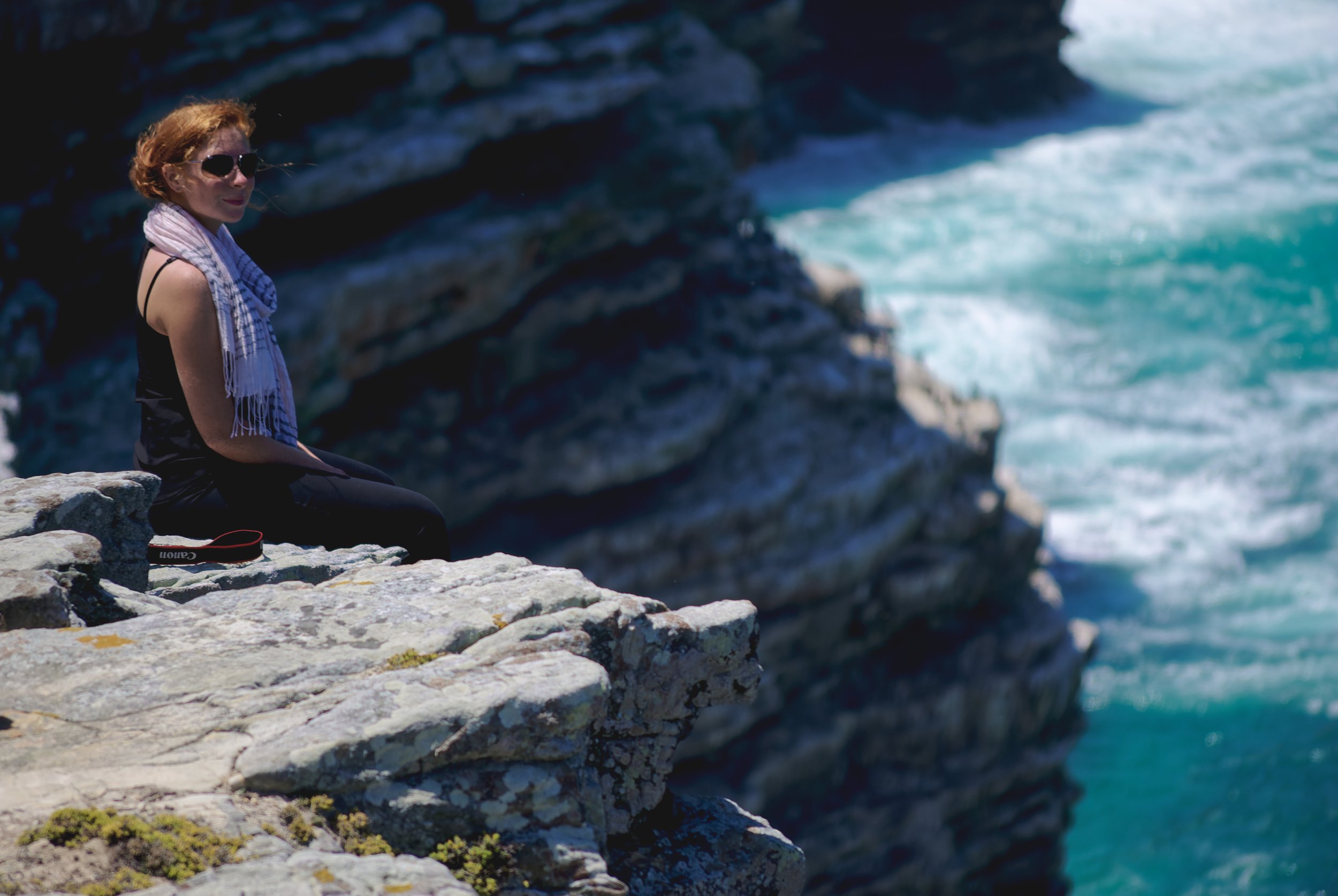204 - Good Hope On The Table (Cape Town, South Africa)
“The sea, once it casts its spell, holds one in its net of wonder forever.”
-- Jacques Yves Cousteau
WE DIDN’T INTEND TO DRIVE ALL THE WAY FROM OUDTSHOORN TO CAPE TOWN, but that’s how the cookie crumbled. And since we didn’t plan on being there, we had no plan for lodging. So, we took the next logical step—drove aimlessly for hours. Yes.
After driving for weeks outside metropolitan areas, I wasn’t mentally prepared for Cape Town traffic. This explains why I drove straight through it until I hit the Atlantic coastal suburbs. We stopped by the water to get our bearings and ate lunch in what felt like a mini-hurricane. It can get windy on the west side of Table Mountain. This was our first view of the so-called “Table Cloth,” the signature cloud cover that often obscures the mountaintop. Nice.
For the shits and giggles, we went south down the coast hoping to find a place outside the hustle and bustle, at least for a night or two. The coastal drive is stunning and well worth your time, but had we known the most striking section is a toll road, we would’ve saved it for another day. Our search for suitable lodging ended in failure, so back to Cape Town.
The hilly terrain, one-way streets, somewhat tumultuous traffic, and my manual transmission ineptitude made for an anxiety-infused afternoon. We found a place (overpriced as usual) but parking was less than ideal. Petty theft was also an issue. We were instructed to remove all valuables from our vehicle. Super.
Cape Town is fascinating—rich history, unique culture, eclectic population, etc. It’s also overrun with tourists and a tad pricey as a consequence. Good for Cape Town, bad for folks trying to avoid the hordes. A lack of a foresight led to an urban plan that feels claustrophobic in areas. Still, the appeal is obvious. Go.
We spent a day or so getting oriented, which meant finding a better place to stay and extending our car-rental contract. The latter turned into an epic struggle: Avis Rental Car: The Never-Ending Saga. They do try harder… to confuse the shit out of you. Suffice it to say, that after two months of back and forth, we swapped our VW Polo Vivo for a shiny white Chevrolet Spark. Catch the fever. It’s not a spark, it’s a fucking inferno… with air-conditioning.
We landed at Scalabrini Guesthouse for three nights. The guesthouse is above the Scalabrini Center, a welfare organization that offers training and assistance to Cape Town’s disadvantaged. All profits from the guesthouse benefit the center. It has excellent facilities and rooms are reasonably priced. Stay.
“On the top of our ‘to do’ list was extending our rental car contract for another month. We also needed to look into switching vehicles, as ours was due for maintenance. It all sounds easy, but I can assure you it’s not. We literally lost days dealing with Avis over the course of two months. Their slogan ‘We try harder’ should be ‘You try harder’, because that’s all we did. Try. Try. Try… and try again. I can’t even tell you how much time and money was wasted. I hate to say it, but Avis sucks. There is just no getting around it. Let’s just say that if I had a nickel for every time they made me drop an F-bomb, I’d be rich.
To make a long story short, the people at Avis don’t know the meaning of ‘extension’. They also don’t know that it’s a bad idea to lease out cars due for maintenance, or that a car might actually get dirty after a few weeks on the road; in Africa, no less. So, two migraines later, it’s out with the Polo and in with the Spark.”
Leslie Peralta, “Cape Town” — Soledad: Notes From My Travels
One of our first explorations included the District Six Museum. District Six is the name given to the inner city area of Cape Town that once housed ten percent of the city’s population. Its denizens were extremely diverse and included immigrants, former slaves, merchants, and just about anyone from a non-Caucasian background. It was to become the essence of injustice during the apartheid regime when forced relocations began in 1968.
“District Six Museum is a museum in the former inner-city residential area and, District Six, in Cape Town, South Africa in an old Methodist church.
District Six Foundation was founded in 1989 and the museum in 1994, as a memorial to the forced movement of 60,000 inhabitants of various races in District Six during Apartheid in South Africa in the 1970s.” From Wikipedia.
The “dangerous” intermingling of races and its status as a den of sin were the official reasons given for the removals, but in the end, it was more about prime real estate than anything else. In an ironic twist, the area was never redeveloped because of the project’s controversial nature and the international attention it garnered. After apartheid ended, a trust was set up to settle claims of former residents. Better late than never… I think.
The next morning, we drove to the Cape of Good Hope with a breakfast picnic on a spectacular beach along the way. Even the three lumps of sand in our coffee, courtesy of the wind, weren’t enough to spoil that scene. If I had to recommend a “must do,” it would be renting a car and driving out to the Cape with plenty of stops. Take it slow. Take it in. Stand upon the cliffs near Cape Point and let the breeze envelop you, the shimmering azure sea mesmerize you, and try to imagine being the first human to lay eyes upon it. Yessir, ma’am.
Your only problem will be tearing yourself away. Get there as early as possible, and do your best to beat the crowds. The tour bus enthusiasts receive just a taste. Most seem content to snap a pic near the sign reading, “Cape of Good Hope: The Most South-Western Point of the African Continent.” Whippty-fucking-do-dah-day, am I right? Get the photo but make sure you get more than that. South-western? Yup. The southernmost point in Africa is Cape Agulhas. So there.
Courtesy of lostintravel.at
Courtesy of Luke Maximo Bell
Courtesy of Topvirtualtours Com
Every time we passed these signs, I felt obligated to scream, "Baboons!” Can't imagine Leslie found that annoying… at all.
What the fuck are you looking at?!
You can’t go to Cape Town without heading up Table Mountain. Ya just can’t. If you get there early, it can be borderline enchanting. Wait too long, and you’ll be swimming through a sea of humanity. In addition to cable car access, there are over three hundred climbing routes to the tippy-top. I don’t t regret taking the cable car, but I wish I’d attempted the Indians Window Route as well. It ain’t no joke, and people die every year. You don’t need special equipment, but parts of the route are straight up the cliffs. The weather can turn on a dime, and it’s possible to make wrong turns. Still, I should’ve tried. Only the things you do not do… sigh.
The views from atop the mountain are undeniably stirring, especially when the scene is painted with clouds. The domain of the gods. That’s what I saw… until the mortals started shuffling off the cable car en masse. To the west, I could just make out the infamous Robben Island, home to one of the world’s most famous prisons and Nelson Mandela’s “residence” for over twenty years.
I briefly considered staying an extra day to give Indians Window a shot, but decided to keep on keeping on. It was the right call. The weather was poopy the next day. So, we headed south toward the coastal city of Gansbaai. We made a wrong turn, driving through a township just outside Cape Town, an area known as the Cape Flats. Bad call, boss. While stopped at a T-junction, a man driving a local bus gave us a helping hand, pointing us in the right direction. He did so in a subtle “what-the-hell-are-you-doing-here-you-crazy-ignorant-bastards” voice. There was real concern in his tone, the kind that made me think we were on the verge of getting fucked up by miscreants.
I admit it. On more than one occasion, when we mistakenly entered a township, I pooped a little. Oh, no! We’re surrounded by poor black people! Ruuuun! Racism? Negative ghost rider. The area, if not the whole of South Africa, is infamous for a harsh reality. The chasm between rich and poor (i.e. black and white) is one of, if not the widest in the world. This is the sad legacy of apartheid. Inequality breeds poverty. Poverty breeds criminal activity. No getting around it. Throw in a healthy (if not justified) resentment of Whitey and the Gang, and you might understand why two Yahoo American tourists in a shiny white Chevrolet Spark containing heaps of visible belongings might experience a teensy bit of distress when crossing a township… or we’re raging assholes. Potato. Potatoe.
“There’s a lot of hype surrounding Cape Town. I’m not sure if I agree with all of it, but it’s definitely an interesting city, to say the least. After a long day of driving, we arrived unprepared for the sudden change of pace. Peace and quiet on the open road was swapped for traffic jams, a maze of one-way streets, and pedestrians lining the sidewalks. Oh, I almost forgot about the cyclists – they’re everywhere. Sensory overload, my friends.
After a few wrong turns and close calls, we made our way out of the city. We drove until we saw the ocean and proceeded south. Sometimes it’s best to get your feet wet before diving in, headfirst – this was definitely one of those times.
With the Atlantic on our side, we were able to breathe easy for a while. The drive was lovely, but we had business to tend to: we needed a place to stay. We searched high and low, but came up empty handed, forcing us to return to the madness. We eventually landed at a comfortable (overpriced) guesthouse on a side street, tucked away from the hustle and bustle. We camped out for a few nights, enjoying the little luxuries, like a bed with clean sheets and a kitchen – two things I’ll never take for granted.
On the top of our ‘to do’ list was extending our rental car contract for another month. We also needed to look into switching vehicles, as ours was due for maintenance. It all sounds easy, but I can assure you it’s not. We literally lost days dealing with Avis over the course of two months. Their slogan ‘We try harder’ should be ‘You try harder’, because that’s all we did. Try. Try. Try… and try again. I can’t even tell you how much time and money was wasted. I hate to say it, but Avis sucks. There is just no getting around it. Let’s just say that if I had a nickel for every time they made me drop an F-bomb, I’d be rich.
To make a long story short, the people at Avis don’t know the meaning of ‘extension’. They also don’t know that it’s a bad idea to lease out cars due for maintenance, or that a car might actually get dirty after a few weeks on the road; in Africa, no less. So, two migraines later, it’s out with the Polo and in with the Spark.
Once we got our bearings, we ended up having a great time in Cape Town. The area has some great museums; most notable are District Six and Iziko Slave Lodge. You can’t scratch the surface of South Africa without acknowledging Apartheid and the way in which it changed everything. District Six takes you back to 1968, when the forced relocations began. It offers a glimpse into what life was like for those at the time, struggling for a voice. The Iziko Slave Lodge was fascinating as well. The exhibit on Nelson Mandela is not to be missed. In fact, I’d love to revisit it. He’s one in a million; the type of person you can’t sum up if you tried. They did a wonderful job attempting too, though.
The next morning we got up early and drove out to the Cape of Good Hope, making several stops along the way. Looking back, that day lands a spot as one of my most memorable while abroad. I’m not sure if it was the weather, scenery, or sidekick that made it so enjoyable – I’m guessing a little of each.
Side note: If you make it to Cape Town, do consider staying at Scalabrini Guest House. All proceeds go directly to the Scalabrini Center, located below it. They’re doing some great things in the community, helping those in need. http://www.scalabrini.org.za/
Also, Table Mountain is worth a visit. Check the forecast, go early, and bring a jacket.”
Leslie Peralta, “Cape Town” — Soledad: Notes From My Travels



























































